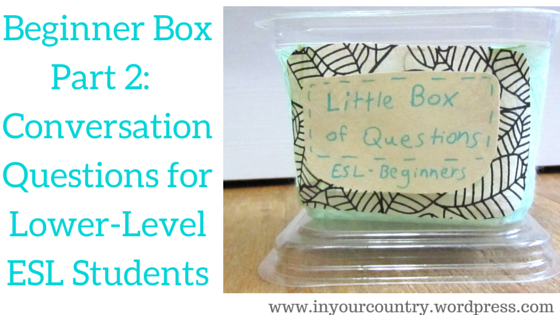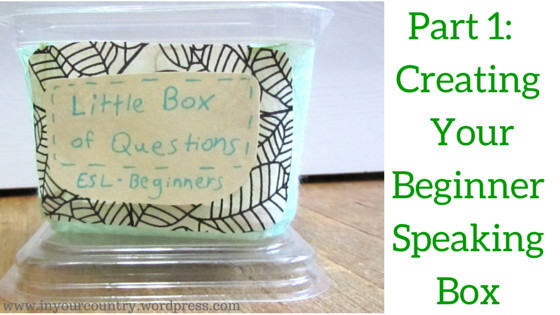
*******Update: New Stufft Alert**********
Hi everyone! I’ve been working on a new site, and I just wanted to let you know that I’ve been putting together a collection of conversation questions on a variety of topics over there. Most of the questions are intended for lower-level English learners, and would be perfect for a conversation box. And best of all, every set of questions comes with a printable worksheet for you. You can find the new questions over here: Beginner-friendly speaking questions
***********************************************
Yesterday I posted about creating a question box geared toward your Beginner ESL students. Today I’m going to give you a big list of simple questions to fill your box with. There are tons of lists of conversation questions on the internet, but most that I can find are aimed toward Intermediate students and above. My goal is to create a massive resource for teachers of lower-level classes who want to get their students chatting.
I’m trying to keep the questions simple, with no phrasal verbs or idioms. Some of them may require students to look a word or two up in the dictionary, but not more than that. Some of them are yes/no questions, but if the student is ready, you can encourage them to elaborate. For example, if the question is, “Do you like dogs?” Your student might say, “Yes, I do. I have a dog. My dog’s name is LuLu. She is brown and white. She is friendly.” Etc…
Please keep in mind that this is a growing list, and I plan to update it regularly, so if you have any suggestions on questions or categories to add, please leave a comment in the box at the bottom of the page.
The Categories
I’ve organized the list into the following categories:
- Simple present
- Simple past
- Future (Includes “will,” “going to,” “want to,” and “would like to”)
- Describe… / Talk about…
- Opinion questions
I would suggest color-coding your question cards (blue for present, pink for past, etc.) to make it easier for students to pick questions that are relevant to them. Again, this list is a work in progress, so if you have suggestions for other categories, feel free to let me know.
The Questions (so far)
Simple Present
- Are you happy today? Why?
- Are you tired? Why?
- Are you hungry? What do you want to eat?
- When are you angry?
- Are you hot or cold today?
- What do you do every day?
- Where do you go on the weekend? (Saturday and Sunday)
- Where do you go after class?
- What is your favorite restaurant? Where is it?
- Who is your favorite musician?
- What is your favorite comedy movie?
- What is your favorite action movie?
- Do you like horror movies? Why or why not?
- Is your city safe or dangerous?
- Is your city exciting or boring?
- Do you prefer dogs or cats? Why?
- Do you prefer hot weather or cold weather? Why?
- Is a monkey a good pet? Why?
- Is a mouse a good pet? Why?
- What animals live in your city?
- What’s your favorite animal?
- What’s your favorite food?
- What do you drink on hot days?
- What do you drink on cold days?
- What do you eat on hot days?
- What do you eat on cold days?
Simple Past
- Where did you go yesterday?
- What did you see yesterday?
- What did you eat for breakfast?
- What did you eat last night?
- Where did you travel last year?
- What was the last thing you bought?
- Did you exercise last week? How?
- When did you last play sports?
- What did you last cook?
- Did you speak English yesterday? Who did you speak to?
Future
- What are you going to do after school today?
- What will you do after you learn English?
- What will you do this weekend?
- What would you like to eat today?
- What are you going to eat this evening?
- What are you going to eat for lunch?
- What will you do after you learn English?
- Who are you going to speak to later?
Note: The prompts in the next two categories (Talk About and What Do You Think About…) are intentionally open-ended. Encourage students to say anything that comes to mind on the subject. You will probably need to teach the meaning of “Talk about” and “What do you think about,” but students will catch on quickly.
Talk About:
- Talk about your family.
- Talk about your hometown.
- Talk about your neighborhood.
- Talk about transportation in your hometown.
- Talk about food in your country.
- Talk about shopping.
- Talk about clothing.
- Talk about a famous person from your country.
- Talk about the weather.
- Talk about your house.
- Talk about your first day in this city.
- Talk about animals.
- Talk about police officers.
- Talk about doctors.
- Talk about school.
- Talk about horses.
- Talk about summer fruit.
- Talk about recycling.
- Talk about winter.
- Talk about summer.
- Talk about spring.
- Talk about fall (autumn).
- Talk about your job.
- Talk about coffee or tea.
- Talk about apples.
What Do You Think About…?
- What do you think about animals?
- What do you think about cars?
- What do you think about bicycles?
- What do you think about books?
- What do you think about new technology?
- What do you think about sports?
- What do you think about crowded places?
- What do you think about children?
- What do you think about fast food?
- What do you think about chocolate?
- What do you think about makeup?
- What do you think about vintage clothing?
- What do you think about horror movies?
- What do you think about action movies?
- What do you think about comic books and animation?
Thanks for taking a look at my gradually-growing list. I hope you find it helpful. If you decide to use them in your class, I’d love to know how they worked out for you. And if you have any suggestions for new questions or categories, please don’t hesitate to let me know!
Links to more Questions:
Conversation questions about food: Yum!
Conversation questions about animals: Woof!
Conversation questions about feelings: Happy!
Conversation questions about homes: Home!
And the general, constantly-growing list of speaking questions for lower levels at my new site, ESL Airplane: Beginner-friendly speaking questions
 In case you’re planning a Halloween lesson for next week, I’d like to share a list of conversation questions to get your students chatting about the holiday. The questions are mainly in simple present and simple past tenses, so they can be used with high-beginner classes and up.
In case you’re planning a Halloween lesson for next week, I’d like to share a list of conversation questions to get your students chatting about the holiday. The questions are mainly in simple present and simple past tenses, so they can be used with high-beginner classes and up.







